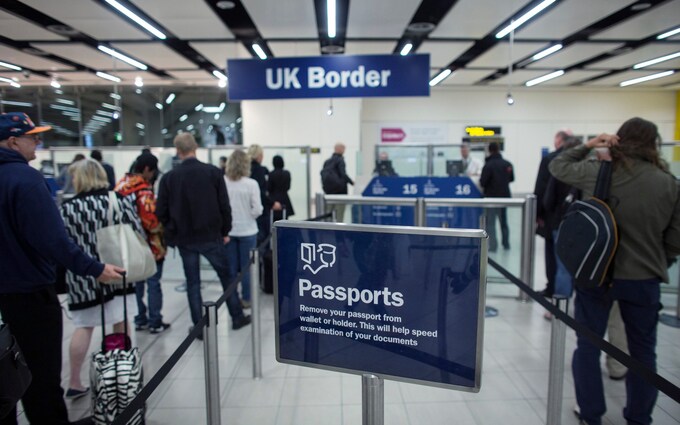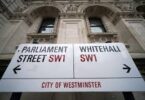Fraser Nelson
How can any country accidentally let in a million immigrants? Brexit was supposed to dial it all back, ushering in a new economic model where employers would be forced to rely on the domestic workforce. Care homes would, finally, have to recruit locally – and pay properly. Instead, real-term salaries plunged and immigration doubled – leading to the panic now underway. The number of health and social care visas has risen fivefold in just three years, according to figures out yesterday. So what went wrong? And how?
So often, the policies that most shape societies – for good and ill – come about by mistake rather than design. This is a classic example. Immigration has changed the face of Britain: newcomers account for one in five workers (a higher ratio than the US) and almost one in three new mums. A higher birth rate means the UK is one of the few major countries not fretting about a fall in the working-age population. So this is not the story of disaster: for all of the current tensions, Britain can still claim to be Europe’s most successful melting pot. But this wasn’t intentional.
Everyone thought that Brexit would lead to less immigration. It was seen to be obvious, which is why so many Remainers portrayed Brexit as a xenophobic, anti-migrant project. The economic scare studies from Remain saying we’d be poorer usually included the assumption that immigration rates would plummet. “What about GDP per head?” said the Brexiteers. But all sides agreed that numbers would drop, which is partly why Boris Johnson loosened the migration rules. He felt he could afford to: numbers were sure to fall. Covid arrived just weeks after Britain left the EU, so the new visa system was not properly tested. When lockdowns ended, the urgent mission was rebuilding the economy and it had become horribly clear that the Great British workforce was not rushing back to the office. Immigrants who came to study were allowed to stay for two years to job hunt. The salary threshold for a visa was lowered from £30,000 to £25,600. Rules on bringing dependants were loosened.
The first odd sign came from the UK Visas authority, which prides itself on issuing paperwork in good time and submitted a request for more staff to handle a quadrupling of demand. This wasn’t seen as alarming but, instead, the start of the post-Brexit visa era and the unwinding of lockdown. The finest minds in England thought things were still on track. As late as November 2022, the Office for Budget Responsibility (OBR) said net migration would be 230,000 the next year. The actual figure was three times higher.
The dots were there, but no one had joined them. The number of dependent visas rose fourfold. Just one in four visas issued was for work. The 2019 Tory target to have 600,000 foreign students by 2030 was hit in 2021, an astonishing nine years early. But this didn’t cause alarm or make people ask whether a scam may be going on where colleges were offering Mickey Mouse degrees so foreign students could bring their family and exploit a loophole. Political attention was elsewhere (mainly on the emerging small boats crisis).
Three factors had blinded ministers to what was happening. The first was the wildly-wrong modelling: the OBR was no more accurate with migration than Sage was with Covid. Next, the OBR’s crude calculation: that every 100,000 immigrants would mean £1?billion more “headroom” to lift spending or cut taxes. It didn’t properly factor in the cost of public services or the rise in dependants’ visas. Worst of all, ministers had started to take such figures as gospel – when the OBR has always stressed that its figures are simplistic and “subject to significant uncertainty”.
That is an understatement. Immigration and population projections have been wrong for decades – and with big consequences. Enoch Powell gave his “rivers of blood” speech using official figures predicting that the population was about to surge. It didn’t. Before Tony Blair gave full employment rights to workers from new EU member states in 2004, the Home Office published a report saying no more than 13,000 a year would come. In the end, 50,000 a year did. So post-Brexit migration forecasts belong in this tradition of statistical fiction. There were dissenters. Suella Braverman, Robert Jenrick, Theresa May all questioned the economic benefits suggested by the Treasury and warned that getting it wrong would put pressure on everything from school places to community cohesion. “But that didn’t bother Rishi, Liz or Boris,” says one minister who worked under all three. “They are liberals. They wanted the GDP. They knew far more may end up coming but they’d say “oh dear, never mind, let’s bank the extra cash”.
The wiring of government has always had an inherent pro-migration bias. Look around the Cabinet table and ask: who has a vested interest to control numbers? Not HM Treasury: they want every penny of what their models say is extra revenue. The education secretary wants foreign students and their fees. The health secretary needs nurses and care workers to fill huge vacancies. Transport needs lorry drivers and agriculture the farm workers. A housing minister might be anxious: where might they all live? But attempts to model the accommodation pressures fell flat. Then there were the liberal commentators, like me, relaxed about mass immigration. I was (and remain) keen to see a successful, liberal model of Brexit where borders stay open but the intake is controlled.
Remainers were wrong to say Brexit would hoist up the drawbridge. Leavers were wrong to say there’d be a better mix of fewer, higher-skilled people. We instead ended up with something no one envisaged: the unintended trebling of immigration, covering up what may soon be the worst welfare crisis in history. I’d still argue that we have the tools to get the balance right between migration, welfare and wages. But hopes for this will lie with a Labour government, it seems, given that the Tories really do seem to have blown it.
The Telegraph







